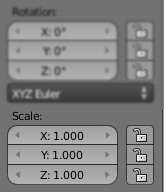Doc:2.6/Manual/3D interaction/Transformations/Basics/Scale
Scale
Mode: Object and Edit modes
Hotkey: S
Menu: Object/Mesh/Curve/Surface » Transform » Scale
Description
Pressing S will enter the Scale transformation mode where the selected element is scaled inward or outward according to the mouse pointer’s location. The element's scale will increase as the mouse pointer is moved away from the Pivot Point and decrease as the pointer is moved towards it. If the mouse pointer crosses from the original side of the Pivot Point to the opposite side, the scale will continue in the negative direction and flip the element.
Read more about Pivot Points »
There are multiple ways to scale an element which include:
- The keyboard shortcut (S)
- The 3D manipulator widget
- The Properties menu (N)
Basic scale usage and common options are described below. For additional information, you may wish to read the Transform Control and Orientation pages which provide more information about options such as Precision, Axis Locking, Numeric Input, Snapping and the different types of Pivot Point.
Read more about Transform Control »
Read more about Transform Orientations »
Usage
Scaling using the keyboard shortcut
- Use RMB
 to select the elements you want to scale.
to select the elements you want to scale. - Tap S once to enter scale mode.
- Scale the elements by moving the mouse.
- LMB
 click to accept changes.
click to accept changes.
The amount of scaling will be displayed in the bottom left hand corner of the 3D window.
Constraining the scaling axis (axis locking)
Scaling can be constrained to a particular axis or axes through the use of Axis Locking. To constrain scaling, the following shortcuts can be used:
- S, X: Scale only along the X Axis
- S, Y: Scale only along the Y Axis
- S, Z: Scale only along the Z Axis
Axis locking can also be enabled by pressing the MMB ![]() after enabling scaling and moving the mouse in the desired direction e.g.
after enabling scaling and moving the mouse in the desired direction e.g.
Read more about Axis Locking »
Fine Tuning The Scaling
Precise control can be had over scaling through the use of the ⇧ Shift and Ctrl keys to limit scaling to discrete amounts. You can also enter a numerical value in Blender Units (BU) to specify the amount of scaling after after initiating a scale transformation.
- Hold Ctrl down while scaling to scale the selected element in degree 0.1 BU increments.
- Hold ⇧ Shift down while scaling to scale the selected element in very fine increments.
- Hold ⇧ ShiftCtrl down while scaling to scale the selected element in 0.01 BU increments.
- Press S, type in a number and press ↵ Enter to confirm.
| Orientation dependent scaling | |
| By default, all scaling happens around a Global Orientation. You can change the scaling orientation by pressing the axis key twice. For example, pressing S, X, X will by default set scaling to occur around the local orientation. |
Read more about Precision Control »
Read more about Numerical Transformations »
Read more about Transform Orientations »
Scaling with the 3D Transform Manipulator
In the 3D View header, ensure that the Transform Manipulator is enabled (the red, green, and blue triad is selected). Set the manipulator type to scale (the highlighted square icon shown below).
![]()
- Select your element with RMB
 .
. - Use LMB
 and drag any of the three colored axes on the scaling manipulator to scale your object along that axis. You can also use ⇧ Shift, Ctrl or numeric input with the 3D manipulator widget for further control.
and drag any of the three colored axes on the scaling manipulator to scale your object along that axis. You can also use ⇧ Shift, Ctrl or numeric input with the 3D manipulator widget for further control. - Your changes will be applied when you release LMB
 or press Space or ↵ Enter. Your changes will be cancelled if you press RMB
or press Space or ↵ Enter. Your changes will be cancelled if you press RMB  or Esc.
or Esc.
Read more about the 3D Transform Manipulator »
Scaling with the Properties Panel
Scale values can also be specified in the Properties panel (N) by altering the amount value in the scaling slider of the Transform panel. Scaling along particular axes can be enabled or disabled by toggling the padlock icon.
Read more about Panels »
Read more about scaling modes »

